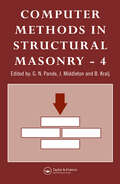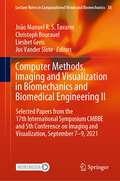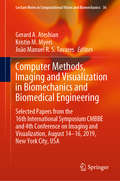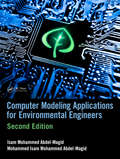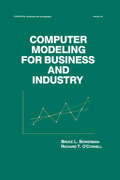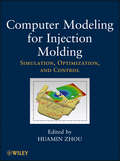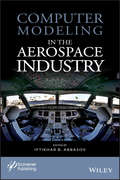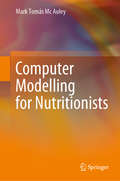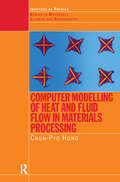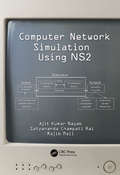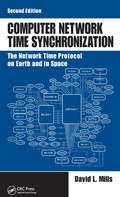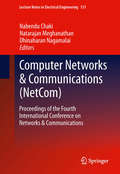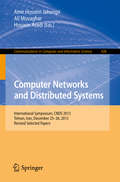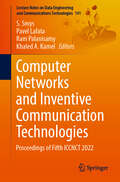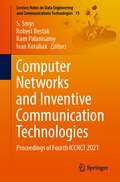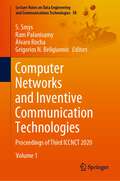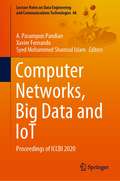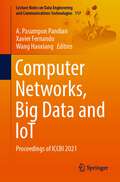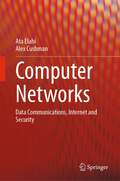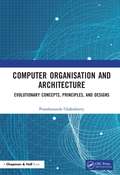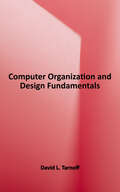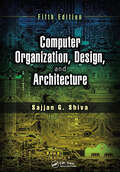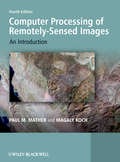- Table View
- List View
Computer Methods in Structural Masonry - 4: Fourth International Symposium
by J. Middleton G. N. Pande B. KraljThe proceedings of the fourth symposium on this topic examine the rapid advances and innovations being made in the theoretical and applied aspects of structural masonry. Focusing on the integration of computer modelling with experimental methods, assessment techniques, restoration and retro-fitting procedures, this is a thorough examination of the
Computer Methods, Imaging and Visualization in Biomechanics and Biomedical Engineering II: Selected Papers from the 17th International Symposium CMBBE and 5th Conference on Imaging and Visualization, September 7-9, 2021 (Lecture Notes in Computational Vision and Biomechanics #38)
by João Manuel R. S. Tavares Liesbet Geris Christoph Bourauel Jos Vander SloteThis book gathers selected, extended and revised contributions to the 17th International Symposium on Computer Methods in Biomechanics and Biomedical Engineering and the 5th Conference on Imaging and Visualization (CMBBE 2021), held online on September 7-9, 2021, from Bonn, Germany. It reports on cutting-edge models, algorithms and imaging techniques for studying cells, tissues and organs in normal and pathological conditions. It covers numerical and machine learning methods, finite element modeling and virtual reality techniques, applied to understand biomechanics of movement, fluid and soft tissue biomechanics. It also reports on related advances in rehabilitation, surgery and diagnosis. All in all, this book offers a timely snapshot of the latest research and current challenges at the interface between biomedical engineering, computational biomechanics and biological imaging. Thus, it is expected to provide a source of inspiration for future research and cross-disciplinary collaborations.
Computer Methods, Imaging and Visualization in Biomechanics and Biomedical Engineering: Selected Papers from the 16th International Symposium CMBBE and 4th Conference on Imaging and Visualization, August 14-16, 2019, New York City, USA (Lecture Notes in Computational Vision and Biomechanics #36)
by João Manuel R. S. Tavares Gerard A. Ateshian Kristin M. MyersThis book gathers selected, extended and revised contributions to the 16th International Symposium on Computer Methods in Biomechanics and Biomedical Engineering, and the 4th Conference on Imaging and Visualization (CMBBE 2019), held on August 14-16, 2019, in New York City, USA. It reports on cutting-edge models and algorithms for studying various tissues and organs in normal and pathological conditions; innovative imaging and visualization techniques; and the latest diagnostic tools. Further topics addressed include: numerical methods, machine learning approaches, FEM models, and high-resolution imaging and real-time visualization methods applied for biomedical purposes. Given the scope of its coverage, the book provides graduate students and researchers with a timely and insightful snapshot of the latest research and current challenges in biomedical engineering, computational biomechanics and biological imaging, as well as a source of inspiration for future research and cross-disciplinary collaborations.
Computer Modeling Applications for Environmental Engineers
by Isam Mohammed Abdel-Magid Ahmed Mohammed Isam Mohammed Abdel-MagidComputer Modeling Applications for Environmental Engineers in its second edition incorporates changes and introduces new concepts using Visual Basic.NET, a programming language chosen for its ease of comprehensive usage. This book offers a complete understanding of the basic principles of environmental engineering and integrates new sections that address Noise Pollution and Abatement and municipal solid-waste problem solving, financing of waste facilities, and the engineering of treatment methods that address sanitary landfill, biochemical processes, and combustion and energy recovery. Its practical approach serves to aid in the teaching of environmental engineering unit operations and processes design and demonstrates effective problem-solving practices that facilitate self-teaching. A vital reference for students and professional sanitary and environmental engineers this work also serves as a stand-alone problem-solving text with well-defined, real-work examples and explanations.
Computer Modeling and Simulation of Dynamic Systems Using Wolfram SystemModeler
by Shaharin Anwar Sulaiman Kirill Rozhdestvensky Vladimir Ryzhov Tatiana Fedorova Kirill Safronov Nikita Tryaskin Mark Ovinis Suhaimi HassanThis book briefly discusses the main provisions of the theory of modeling. It also describes in detail the methodology for constructing computer models of dynamic systems using the Wolfram visual modeling environment, SystemModeler, and provides illustrative examples of solving problems of mechanics and hydraulics. Intended for students and professionals in the field, the book also serves as a supplement to university courses in modeling and simulation of dynamic systems.
Computer Modeling for Business and Industry (Statistics: A Series Of Textbooks And Monographs #59)
by Bruce L. BowermanThis book is intended to be primarily a supplemental text that can be used to integrate the use of computer packages into introductory business statistics and quantitative methods courses, demonstrating how computer packages can be used to solve statistical and operational research problems.
Computer Modeling for Injection Molding
by Huamin ZhouThis book covers a wide range of applications and uses of simulation and modeling techniques in polymer injection molding, filling a noticeable gap in the literature of design, manufacturing, and the use of plastics injection molding. The authors help readers solve problems in the advanced control, simulation, monitoring, and optimization of injection molding processes. The book provides a tool for researchers and engineers to calculate the mold filling, optimization of processing control, and quality estimation before prototype molding.
Computer Modeling in the Aerospace Industry
by Iftikhar B. AbbasovDevoted to advances in the field of computer simulation of aerospace equipment, this study is the most up-to-date coverage of the state-of-the-art on coastal and passenger aircraft, drones, and other recent developments in this constantly changing field. This book is devoted to unique developments in the field of computer modeling in aerospace engineering. The book describes the original conceptual models of amphibious aircraft, ground-effect vehicles, hydrofoil vessels, and others, from theory to the full implementation in industrial applications. The developed models are presented with the design of passenger compartments and are actually ready for implementation in the aircraft industry. The originality of the concepts are based on biological prototypes, which are ergonomic, multifunctional and aesthetically pleasing. The aerodynamic layout of prospective convertible land and ship-based aircrafts of vertical and short takeoff-landing is presented, as well as the development of the original model of the unmanned aerial vehicle, or drone. The results of full-scale experiments are presented, including the technology of modeling aerospace simulators based on the virtual reality environment with technical vision devices. Whether for the practicing engineer in the field, the engineering student, or the scientist interested in new aerospace developments, this volume is a must-have. This groundbreaking new volume: Presents unique developments of coastal aircraft concepts based on biological prototypes, from the idea to the finished model Gives the process of modeling the original unmanned aerial vehicle Investigates aerospace simulators based on virtual reality environment with technical vision devices Covers the original ideas of creating carrier-based aviation for sea ships and the results of field experiments simulating an unmanned aerial vehicle Provides many useful illustrations of naval aviation Audience: The book is intended for aerospace engineers, mechanical engineers, structural engineers, researchers and developers in the field of aerospace industry, for aircraft designers and engineering students. It will be useful for scientists, students, graduate students and engineers in the field of naval aviation and space simulators.
Computer Modelling for Nutritionists
by Mark Tomás Mc AuleyThis book draws on Mark Mc Auley’s wealth of experience to provide an intuitive step-by-step guide to the modelling process. It also provides case studies detailing the creation of biological process models. Mark Mc Auley has over 15 years’ experience of applying computing to challenges in bioscience. Currently he is employed as a Senior Lecturer in Chemical Engineering at the University of Chester. He has published widely on the use of computer modelling in nutrition and uses computer modelling to both enhance and enrich the learning experience of the students that he teaches. He has taught computer modelling to individuals at a wide variety of levels and from different backgrounds, from undergraduate nutrition students to PhD and medical students.
Computer Modelling of Heat and Fluid Flow in Materials Processing (Series In Materials Science And Engineering Ser.)
by C.P. HongThe understanding and control of transport phenomena in materials processing play an important role in the improvement of conventional processes and in the development of new techniques. Computer modeling of these phenomena can be used effectively for this purpose. Although there are several books in the literature covering the analysis of heat tra
Computer Network Simulation Using NS2
by Ajit Kumar Nayak Satyananda Champati Rai Rajib MallComputer Network Simulations Using NS2 provides a solid foundation of computer networking knowledge and skills, covering everything from simple operating system commands to the analysis of complex network performance metrics. The book begins with a discussion of the evolution of data communication techniques and the fundamental issues associated with performance evaluation. After presenting a preliminary overview of simulation and other performance evaluation techniques, the authors: Describe a number of computer network protocols and TCP/IP and OSI models, highlighting the networking devices used Explain a socket and its use in network programming, fostering the development of network applications using C and socket API Introduce the NS2 network simulator, exhibiting its internal architecture, constituent software packages, and installation in different operating systems Delve into simulation using NS2, elaborating on the use of Tcl and OTcl scripts as well as AWK scripting and plotting with Gnuplot Show how to simulate wired and wireless network protocols step by step, layer by layer Explore the idea of simulating very large networks, identifying the challenges associated with measuring and graphing the various network parameters Include nearly 90 example programs, scripts, and outputs, along with several exercises requiring application of the theory and programming Computer Network Simulations Using NS2 emphasizes the implementation and simulation of real-world computer network protocols, affording readers with valuable opportunities for hands-on practice while instilling a deeper understanding of how computer network protocols work.
Computer Network Time Synchronization: The Network Time Protocol on Earth and in Space, Second Edition
by David L. MillsCarefully coordinated, reliable, and accurate time synchronization is vital to a wide spectrum of fields—from air and ground traffic control, to buying and selling goods and services, to TV network programming. Ill-gotten time could even lead to the unimaginable and cause DNS caches to expire, leaving the entire Internet to implode on the root servers.Written by the original developer of the Network Time Protocol (NTP), Computer Network Time Synchronization: The Network Time Protocol on Earth and in Space, Second Edition addresses the technological infrastructure of time dissemination, distribution, and synchronization—specifically the architecture, protocols, and algorithms of the NTP. This system has been active in one form or another for almost three decades on the Internet and numerous private networks on the nether side of firewalls. Just about everything today that can be connected to a network wire has support for NTP.This book: Describes the principal components of an NTP client and how it works with redundant servers and diverse network paths Provides an in-depth description of cryptographic and other critical algorithms Presents an overview of the engineering principles guiding network configuration Evaluating historic events that have taken place since computer network timekeeping started almost three decades ago, the author details a number of systems and drivers for current radio, satellites, and telephone modem dissemination and explains how we reckon the time, according to the stars and atoms. The original 16 chapters of the first edition have been rewritten, updated, and enhanced with new material. Four new chapters cover new algorithms and previously uncovered concepts, including timekeeping in space missions.Praise for the first edition:"… For those that need an exhaustive tome on all of the minutiae related to NTP and synchronization, this is the source. … definitive … this book should be considered the last word on the topic."—Ben Rothke on Slashdot.org"… the bible of the subject… contains enough information to take you just as far as you want to go….Dr. Mills is the original developer of NTP."—Books On-Line
Computer Networks & Communications: Proceedings of the Fourth International Conference on Networks & Communications (Lecture Notes in Electrical Engineering #131)
by Nabendu Chaki Natarajan Meghanathan Dhinaharan NagamalaiComputer Networks & Communications (NetCom) is the proceedings from the Fourth International Conference on Networks & Communications. This book covers theory, methodology and applications of computer networks, network protocols and wireless networks, data communication technologies, and network security. The proceedings will feature peer-reviewed papers that illustrate research results, projects, surveys and industrial experiences that describe significant advances in the diverse areas of computer networks & communications.
Computer Networks and Distributed Systems: International Symposium, CNDS 2013, Tehran, Iran, December 25-26, 2013, Revised Selected Papers (Communications in Computer and Information Science #428)
by Amir Hossein Jahangir Ali Movaghar Hossein AsadiThis book constitutes the refereed proceedings of the International Symposium on Computer Networks and Distributed Systems, CNDS 2013, held in Tehran, Iran, in December 2013. The 14 full papers presented were carefully reviewed and selected from numerous submissions. They are organized in topical sections such as cognitive and multimedia networks; wireless sensor networks; security; clouds and grids.
Computer Networks and Inventive Communication Technologies: Proceedings of Fifth ICCNCT 2022 (Lecture Notes on Data Engineering and Communications Technologies #141)
by S. Smys Pavel Lafata Ram Palanisamy Khaled A. KamelThis book is a collection of peer-reviewed best selected research papers presented at 5th International Conference on Computer Networks and Inventive Communication Technologies (ICCNCT 2022). The book covers new results in theory, methodology, and applications of computer networks and data communications. It includes original papers on computer networks, network protocols and wireless networks, data communication technologies, and network security. The proceedings of this conference is a valuable resource, dealing with both the important core and the specialized issues in the areas of next generation wireless network design, control, and management, as well as in the areas of protection, assurance, and trust in information security practice. It is a reference for researchers, instructors, students, scientists, engineers, managers, and industry practitioners for advance work in the area.
Computer Networks and Inventive Communication Technologies: Proceedings of Fourth ICCNCT 2021 (Lecture Notes on Data Engineering and Communications Technologies #75)
by S. Smys Robert Bestak Ivan Kotuliak Ram PalanisamyThis book is a collection of peer-reviewed best-selected research papers presented at 4th International Conference on Computer Networks and Inventive Communication Technologies (ICCNCT 2021). The book covers new results in theory, methodology, and applications of computer networks and data communications. It includes original papers on computer networks, network protocols and wireless networks, data communication technologies, and network security. The proceedings of this conference are a valuable resource, dealing with both the important core and the specialized issues in the areas of next-generation wireless network design, control, and management, as well as in the areas of protection, assurance, and trust in information security practice. It is a reference for researchers, instructors, students, scientists, engineers, managers, and industry practitioners for advanced work in the area.
Computer Networks and Inventive Communication Technologies: Proceedings of Third ICCNCT 2020 (Lecture Notes on Data Engineering and Communications Technologies #58)
by Álvaro Rocha S. Smys Ram Palanisamy Grigorios N. BeligiannisThis book is a collection of peer-reviewed best selected research papers presented at 3rd International Conference on Computer Networks and Inventive Communication Technologies (ICCNCT 2020). The book covers new results in theory, methodology, and applications of computer networks and data communications. It includes original papers on computer networks, network protocols and wireless networks, data communication technologies, and network security. The proceedings of this conference is a valuable resource, dealing with both the important core and the specialized issues in the areas of next generation wireless network design, control, and management, as well as in the areas of protection, assurance, and trust in information security practice. It is a reference for researchers, instructors, students, scientists, engineers, managers, and industry practitioners for advance work in the area.
Computer Networks, Big Data and IoT: Proceedings of ICCBI 2020 (Lecture Notes on Data Engineering and Communications Technologies #66)
by Xavier Fernando A. Pasumpon Pandian Syed Mohammed Shamsul IslamThis book presents best selected research papers presented at the International Conference on Computer Networks, Big Data and IoT (ICCBI 2020), organized by Vaigai College Engineering, Madurai, Tamil Nadu, India, during 15–16 December 2020. The book covers original papers on computer networks, network protocols and wireless networks, data communication technologies and network security. The book is a valuable resource and reference for researchers, instructors, students, scientists, engineers, managers and industry practitioners in those important areas.
Computer Networks, Big Data and IoT: Proceedings of ICCBI 2021 (Lecture Notes on Data Engineering and Communications Technologies #117)
by Xavier Fernando A. Pasumpon Pandian Wang HaoxiangThis book presents best selected research papers presented at the International Conference on Computer Networks, Big Data and IoT (ICCBI 2021), organized by Vaigai College Engineering, Madurai, Tamil Nadu, India, during December 9–10, 2021. The book covers original papers on computer networks, network protocols and wireless networks, data communication technologies and network security. The book is a valuable resource and reference for researchers, instructors, students, scientists, engineers, managers and industry practitioners in those important areas.
Computer Networks: Data Communications, Internet and Security
by Ata Elahi Alex CushmanThe hands-on textbook covers both the theory and applications of data communications, the Internet, and network security technology, following the ACM guideline for courses in networking. The content is geared towards upper undergraduate and graduate students in information technology, communications engineering, and computer science. The book is divided into three sections: Data Communications, Internet Architecture, and Network Security. Topics covered include flow control and reliable transmission; modulation, DSL, cable modem, and FTTH; Ethernet and Fast Ethernet; gigabit and 10 gigabit Ethernet; and LAN interconnection devices, among others. The book also covers emerging topics such as IPv6 and software defined networks. The book is accompanied with a lab manual which uses Wireshark, Cisco Packet Tracer, and virtual machines to lead students through simulated labs.
Computer Organisation and Architecture: Evolutionary Concepts, Principles, and Designs
by Pranabananda ChakrabortyComputer organization and architecture is becoming an increasingly important core subject in the areas of computer science and its applications, and information technology constantly steers the relentless revolution going on in this discipline. This textbook demystifies the state of the art using a simple and step-by-step development from traditional fundamentals to the most advanced concepts entwined with this subject, maintaining a reasonable balance among various theoretical principles, numerous design approaches, and their actual practical implementations. Being driven by the diversified knowledge gained directly from working in the constantly changing environment of the information technology (IT) industry, the author sets the stage by describing the modern issues in different areas of this subject. He then continues to effectively provide a comprehensive source of material with exciting new developments using a wealth of concrete examples related to recent regulatory changes in the modern design and architecture of different categories of computer systems associated with real-life instances as case studies, ranging from micro to mini, supermini, mainframes, cluster architectures, massively parallel processing (MPP) systems, and even supercomputers with commodity processors. Many of the topics that are briefly discussed in this book to conserve space for new materials are elaborately described from the design perspective to their ultimate practical implementations with representative schematic diagrams available on the book’s website. Key Features Microprocessor evolutions and their chronological improvements with illustrations taken from Intel, Motorola, and other leading families Multicore concept and subsequent multicore processors, a new standard in processor design Cluster architecture, a vibrant organizational and architectural development in building up massively distributed/parallel systems InfiniBand, a high-speed link for use in cluster system architecture providing a single-system image FireWire, a high-speed serial bus used for both isochronous real-time data transfer and asynchronous applications, especially needed in multimedia and mobile phones Evolution of embedded systems and their specific characteristics Real-time systems and their major design issues in brief Improved main memory technologies with their recent releases of DDR2, DDR3, Rambus DRAM, and Cache DRAM, widely used in all types of modern systems, including large clusters and high-end servers DVD optical disks and flash drives (pen drives) RAID, a common approach to configuring multiple-disk arrangements used in large server-based systems A good number of problems along with their solutions on different topics after their delivery Exhaustive material with respective figures related to the entire text to illustrate many of the computer design, organization, and architecture issues with examples are available online at http://crcpress.com/9780367255732 This book serves as a textbook for graduate-level courses for computer science engineering, information technology, electrical engineering, electronics engineering, computer science, BCA, MCA, and other similar courses.
Computer Organization and Design Fundamentals: Examining Computer Hardware from the Bottom to the Top
by David L. TarnoffComputer Organization and Design Fundamentals take the reader from the basic design principles of the modern digital computer to a top-level examination of its architecture. This book can serve either as a textbook to an introductory course on computer hardware or as the basic text for the aspiring geek who wants to learn about digital design. The material is presented in four parts. The first part describes how computers represent and manipulate numbers. The second part presents the tools used at all levels of binary design. The third part introduces the reader to computer system theory with topics such as memory, caches, hard drives, pipelining, and interrupts. The last part applies these theories through an introduction to the Intel 80x86 architecture and assembly language. The material is presented using practical terms and examples with an aim toward providing anyone who works with computer systems the ability to use them more effectively through a better understanding of their design.
Computer Organization, Design, and Architecture, Fifth Edition
by Sajjan G. ShivaSuitable for a one- or two-semester undergraduate or beginning graduate course in computer science and computer engineering, Computer Organization, Design, and Architecture, Fifth Edition presents the operating principles, capabilities, and limitations of digital computers to enable development of complex yet efficient systems. With 50 percent updated material, 11 new sections, and four revised sections, this edition takes students through a solid, up-to-date exploration of single- and multiple-processor systems, embedded architectures, and performance evaluation.
Computer Principles and Design in Verilog HDL
by Yamin Li Tsinghua University PressUses Verilog HDL to illustrate computer architecture and microprocessor design, allowing readers to readily simulate and adjust the operation of each design, and thus build industrially relevant skills Introduces the computer principles, computer design, and how to use Verilog HDL (Hardware Description Language) to implement the design Provides the skills for designing processor/arithmetic/cpu chips, including the unique application of Verilog HDL material for CPU (central processing unit) implementation Despite the many books on Verilog and computer architecture and microprocessor design, few, if any, use Verilog as a key tool in helping a student to understand these design techniques A companion website includes color figures, Verilog HDL codes, extra test benches not found in the book, and PDFs of the figures and simulation waveforms for instructors
Computer Processing of Remotely-Sensed Images
by Paul Mather Magaly KochThis fourth and full colour edition updates and expands a widely-used textbook aimed at advanced undergraduate and postgraduate students taking courses in remote sensing and GIS in Geography, Geology and Earth/Environmental Science departments. Existing material has been brought up to date and new material has been added. In particular, a new chapter, exploring the two-way links between remote sensing and environmental GIS, has been added.New and updated material includes:A website at www.wiley.com/go/mather4 that provides access to an updated and expanded version of the MIPS image processing software for Microsoft Windows, PowerPoint slideshows of the figures from each chapter, and case studies, including full data sets,Includes new chapter on Remote Sensing and Environmental GIS that provides insights into the ways in which remotely-sensed data can be used synergistically with other spatial data sets, including hydrogeological and archaeological applications,New section on image processing from a computer science perspective presented in a non-technical way, including some remarks on statistics,New material on image transforms, including the analysis of temporal change and data fusion techniques,New material on image classification including decision trees, support vector machines and independent components analysis, andNow in full colour throughout.This book provides the material required for a single semester course in Environmental Remote Sensing plus additional, more advanced, reading for students specialising in some aspect of the subject. It is written largely in non-technical language yet it provides insights into more advanced topics that some may consider too difficult for a non-mathematician to understand. The case studies available from the website are fully-documented research projects complete with original data sets. For readers who do not have access to commercial image processing software, MIPS provides a licence-free, intuitive and comprehensive alternative.
